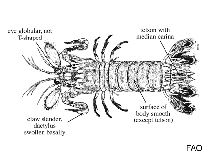Odontodactylus hawaiiensis Maning, 1967
Warning: DOMDocument::load(): SSL operation failed with code 1. OpenSSL Error messages: error:140770FC:SSL routines:SSL23_GET_SERVER_HELLO:unknown protocol in C:\Apache24\htdocs\includes\SpeciesSummary.lib.php on line 1236
Warning: DOMDocument::load(): Failed to enable crypto in C:\Apache24\htdocs\includes\SpeciesSummary.lib.php on line 1236
Warning: DOMDocument::load(https://sealifebase.nrm.se/webservice/AquaMaps/getAMap.php?genus=Odontodactylus&species=hawaiiensis): failed to open stream: operation failed in C:\Apache24\htdocs\includes\SpeciesSummary.lib.php on line 1236
Warning: DOMDocument::load(): I/O warning : failed to load external entity "https://sealifebase.nrm.se/webservice/AquaMaps/getAMap.php?genus=Odontodactylus&species=hawaiiensis" in C:\Apache24\htdocs\includes\SpeciesSummary.lib.php on line 1236
Envoyez vos Photos
Images Google | No image available for this species;
drawing shows typical species in Odontodactylidae.
Images Google | No image available for this species;
drawing shows typical species in Odontodactylidae.
Classification / Names Common names | Synonyms | CoL | ITIS | WoRMS
| Stomatopoda | Odontodactylidae
Environment: milieu / climate zone / depth range / distribution range Écologie
; profondeur 50 - 276 m (Ref. 106682). Tropical
Distribution Pays | Zones FAO | Écosystèmes | Occurrences | Introductions
Pacific Ocean: from New Caledonia to Hawaii and Easter Island. Tropical and subtropical.
Length at first maturity / Taille / Poids / Âge
Maturity: Lm ? range ? - ? cm Max length : 14.5 cm TL mâle / non sexé; (Ref. 3557)
Sublittoral (Ref. 82703).
Life cycle and mating behavior Maturité | Reproduction | Frai | Œufs | Fécondité | Larves
Some members of the order Stomatopoda pair for life and some come together only to mate. Males produce sperm ducts rather than spermatophores; females can brood a maximum of 50,000 eggs. Life cycle: Eggs hatch to a planktonic zoea which lasts for 3 months.
Référence principale
Références | Coordinateur | Collaborateurs
Poupin, J. 2003. (Ref. 2898)
Statut dans la liste rouge de l'IUCN (Ref. 130435)
statut CITES (Ref. 108899)
Not Evaluated
CMS (Ref. 116361)
Not Evaluated
Menace pour l'homme
Harmless
Utilisations par l'homme
| FishSource |
Outils
Plus d'informations
Pays
Zones FAO
Écosystèmes
Occurrences
Introductions
Stocks
Écologie
Régime alimentaire
Éléments du régime alimentaire
Zones FAO
Écosystèmes
Occurrences
Introductions
Stocks
Écologie
Régime alimentaire
Éléments du régime alimentaire
Sources Internet
BHL | BOLD Systems | CISTI | DiscoverLife | FAO(Publication : search) | Fishipedia | GenBank (genome, nucleotide) | GloBI | Gomexsi | Google Books | Google Scholar | Google | PubMed | Arbre de Vie | Wikipedia (Go, chercher) | Zoological Record
Estimates based on models
Preferred temperature
(Ref. 115969): 8 - 23.2, mean 16.9 (based on 136 cells).



